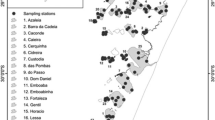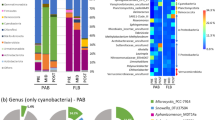Abstract
This study portrays the frequency and intensity of bloom-forming cyanobacteria in relation to highly changing environmental conditions in a floodplain lake from the Chaco-Pampean region and identifies the factors promoting the growth of different species along a 15-year period marked by important drought and flood periods. Phytoplankton in Laguna Grande was increasingly dominated by cyanobacteria represented by eight bloom-forming species bearing different eco-physiological traits. The bloom development showed strong inter-annual variability in correspondence with the depth of the lake that was affected by local rainfall and the ENSO regional phenomenon. The water level of the lake strongly influenced the species composition, favoring non-heterocystous filaments in deep turbid waters and nitrogen fixing in very short well lit, nitrogen-depleted water columns. Species morphology, dimensions and occurrence of akinetes in the filaments also varied in relation to water level. We suggest that the akinete pool of the sediments played a key role on the occurrence of recurrent Anabaenopsis cf. elenkinii and Sphaerospermopsis cf. aphanizonemoides blooms.




Similar content being viewed by others
References
American Public Health Association (APHA), 2005. Standard Methods for the Examination of Water and Wastewater. American Public Health Association, Washington DC.
Ballot, A., P. K. Dadheech, S. Haande & L. Krienitz, 2008. Morphological and phylogenetic analysis of Anabaenopsis abijatae and Anabaenopsis elenkinii (Nostocales, Cyanobacteria) from tropical inland water bodies. Microbial Ecology 55: 608–618.
Carey, C., B. Ibelings, E. Hoffmann, D. Hamilton & J. Brookes, 2012. Eco-physiological adaptations that favour freshwater cyanobacteria in a changing climate. Water Research 46: 1394–1407.
Chen, Y. W., B. Q. Qin, K. Teubner & M. T. Dokulil, 2003. Long-term dynamics of phytoplankton assemblages: microcystis-domination in Lake Taihu, a large shallow lake in China. Journal of Plankton Research 25: 445–453.
Chorus, I. & J. Bartram, 1999. Toxic Cyanobacteria in Water:A Guide to their Public Health Consequences, Monitoring and Management. E. & F. N. Spon, London.
Chu, Z., X. Jin, N. Iwami & Y. Inamori, 2007. The effect of temperature on growth characteristics and competitions of Microcystis aeruginosa and Oscillatoria mougeotii in a shallow eutrophic lake simulator system. Hydrobiologia 581: 217–223.
de Tezanos Pinto, P., L. Allende & I. O’Farrell, 2007. Influence of free floating plants on the structure of a natural phytoplankton assemblage: an experimental approach. Journal of Plankton Research 29: 47–57.
Dokulil, M. T. & K. Teubner, 2000. Cyanobacterial dominance in lakes. Hydrobiologia 438: 1–12.
Downing, J. A., S. B. Watson & E. McCauley, 2001. Predicting Cyanobacteria dominance in lakes. Canadian Journal of Fisheries and Aquatic Science 58: 1905–1908.
Faithfull, C. L. & C. W. Burns, 2006. Effects of salinity and source of inocula on germination of Anabaena akinetes from a tidally influenced lake. Freshwater Biology 51: 705–716.
Ferber, L. R., S. N. Levine, A. Lini & P. Livingston, 2004. Do Cyanobacteria dominate in eutrophic lakes because they fix atmospheric nitrogen? Freshwater Biology 49: 690–708.
Havens, K. E., E. J. Philips, M. E. Cichra & B.-L. Li, 1998. Light availability as a possible regulator of cyanobacteria species composition in a shallow subtropical lake. Freshwater Biology 39: 547–556.
Hense, I. & A. Beckmann, 2006. Towards a model of cyanobacteria life cycle – effects of growing and resting stages on bloom formation of N2 – fixing species. Ecological Modelling 195: 205–218.
Hillebrand, H., C. D. Durselen, D. Kirshtel, U. Pollingher & T. Zohary, 1999. Biovolume calculation for pelagic and benthic microalgae. Journal of Phycology 35: 403–424.
Izaguirre, I., I. O’Farrell, F. Unrein, R. Sinistro, M. dos Santos Afonso & G. Tell, 2004. Algal assemblages across a wetland, from a shallow lake to relictual oxbow lakes (Lower Paraná River, South America). Hydrobiologia 511: 25–36.
Jun, S. & L. Dongyan, 2003. Geometric models for calculating cell biovolume and surface area for phytoplankton. Journal of Plankton Research 25: 1331–1346.
Komárek, J., 2013. Cyanoprokaryota. Heterocytous genera. In Büdel, B., G. Gärtner, L. Krienitz & M. Schagerl (eds), Süsswasserflora von Mitteleuropa 19/3. Elsevier, Berlin: 1–1129.
Komárek, J. & K. Anagnostidis, 1999. Cyanoprokaryota. 1. Chroococcales. In Ettl, H., G. Gärtner, H. Heynig & D. Mollenhauer (eds), Süsswasserflora von Mitteleuropa 19/1. Jena, Stuttgart: 1–548.
Komárek, J. & K. Anagnostidis, 2005. Cyanoprokaryota. 2. Oscillatoriales. In Büdel, B., L. Krienitz, G. Gärtner & M. Schagerl (eds), Süsswasserflora von Mitteleuropa 19/2. München, Heidelberg: 1–759.
Koroleff, F., 1983. Simultaneous oxidation of nitrogen and phosphorus compounds by persulfate. In Grosshoff, K., M. Eberhodt & K. Kremling (eds), Methods of Seawater Analysis. Verlag Chemie, Wainheimer: 168–169.
Litchman, E., P. de Tezanos Pinto, C. A. Klausmeier, M. K. Thomas & K. Yoshiyama, 2010. Linking traits to species diversity and community structure in phytoplankton. Hydrobiologia 653: 15–28.
Lorenzen, C. J., 1967. Determination of chlorophyll and pheopigments: spectrophotometric equations. Limnology and Oceanography 12: 343–346.
Meerhoff, M., M. Beklioglu, R. Burks, F. García-Rodríguez, N. Mazzeo & B. Moss, 2010. Preface. Hydrobiologia 646: 1–3.
Moisander, P. H., E. McClinton & H. W. Paerl, 2002. Salinity effects on growth, photosynthetic parameters, and nitrogenase activity in estuarine planktonic cyanobacteria. Microbial Ecology 43: 432–442.
Moustaka-Gouni, M., E. Vardaka & E. Tryfon, 2007. Phytoplankton species succession in a shallow Mediterranean lake (Lake Kastoria, Greece): Limnothrix redekei, Microcystis aeruginosa and Cylindrospermopsis raciborskii. Hydrobiologia 575: 120–140.
Moustaka-Gouni, M., K. A. Kormas, E. Vardaka, M. Katsiapi & S. Gkelis, 2009. Raphidiopsis mediterranea Skuja represents non-heterocytous life-cycle stages of Cylindrospermopsis raciborskii (Woloszynska) Seenayya & Subba Raju in Lake Kastoria (Greece), its type locality: evidence by morphological and phylogenetic analysis. Harmful Algae 8: 864–872.
Moustaka-Gouni, M., K. A. Kormas, P. Polykarpou, S. Gkelis, D. C. Bobori & E. Vardaka, 2010. Polyphasic evaluation of Aphanizomenon issatschenkoi and Raphidiopsis mediterranea in a Mediterranean lake. Journal of Plankton Research 32: 927–936.
Nixdorf, B., U. Mischke & J. Rücker, 2003. Phytoplankton assemblages and steady state in deep and shallow eutrophic lakes – an approach to differentiate the habitat properties of Oscillatoriales. Hydrobiologia 502: 111–121.
Nöges, T., R. Laugaste, P. Nöges & I. Tönno, 2008. Critical N:P ratio for cyanobacteria and N2-fixing species in the large shallow temperate lakes Peipsi and Vortsjarv. North-East Europe Hydrobiologia 599: 77–86.
Nusch, E. A., 1980. Comparison of different methods for chlorophyll and paeopigment determination. Advances in Limnology 14: 14–36.
O’Farrell, I., P. de Tezanos Pinto, P. L. Rodríguez, G. Chaparro & H. N. Pizarro, 2009. Experimental evidence of the dynamic effect of free-floating plants on phytoplankton ecology. Freshwater Biology 54: 363–375.
O’Farrell, I., I. Izaguirre, G. Chaparro, F. Unrein, R. Sinistro, H. Pizarro, P. L. Rodriguez, P. de Tezanos Pinto, R. Lombardo & G. Tell, 2011. Water level as the main driver of the alternation between a free-floating plant and a phytoplankton dominated state: a long term study in a floodplain lake. Aquatic Sciences 73: 275–287.
Orihel, D. M., D. F. Bird, M. Brylinsky, H. Chen, D. B. Donald, D. Y. Huang, A. Giani, D. Kinniburgh, H. Kling, B. G. Kotak, P. R. Leavitt, C. C. Nielsen, S. Reedyk, R. C. Rooney, S. B. Watson, R. W. Zurawell & R. D. Vinebrooke, 2012. High microcystin concentrations occur only at low nitrogen-to-phosphorus ratios in nutrient-rich Canadian lakes. Canadian Journal of Fisheries and Aquatic Science 69: 1457–1462.
Paerl, H. W., N. S. Hall & E. S. Calandrino, 2011. Controlling harmful cyanobacterial blooms ina a world experiencing anthropogenic and climatic-induced change. Science of the Total Environment 409: 1739–1745.
Paerl, H. W. & V. J. Paul, 2012. Climate change: links to global expansion of harmful cyanobacteria. Water Research 46: 1349–1363.
Peel, H. W. & J. Huisman, 2009. Updated World map of the Köppen–Geiger climate classification. Hydrology and Earth System Sciences 11: 1633–1644.
Phlips, E. J., J. Hendrickson, E. L. Quinlan & M. Cichra, 2007. Meteorological influences on algal bloom potential in a nutrient-rich blackwater river. Freshwater Biology 52: 2141–2155.
Reynolds, C. S., 1997. Vegetation processes in the Pelagic: a model for ecosystem theory. In Kinne, O. (ed.), Excellence in Ecology. Ecology Institute, Oldendorf/Luhe: 1–371.
Santos, K. R. S., F. Rios Jacinavicius & C. L. Sant’Anna, 2011. Effects of the pH on growth and morphology of Anabaenopsis elenkinii Miller (Cyanobacteria) isolated from the alkaline shallow lake of the Brazilian Pantanal. Fottea 11: 119–126.
Scheffer, M., S. Rinaldi, A. Gragnani, L. R. Mur & E. H. Van Nes, 1997. On the dominance of filamentous cyanobacteria in shallow, turbid lakes. Ecology 78: 272–282.
Schindler, D. W., R. E. Hecky, D. L. Findlay, M. P. Stainton, B. R. Parker, M. J. Paterson, K. G. Beaty, M. Lyng & S. E. M. Kasian, 2008. Eutrophication of lakes cannot be controlled by reducing nitrogen input: results of a 37-year whole-ecosystem experiment. PNAS 105: 11254–11258.
Silva Busso, A. & J. Santa Cruz, 2005. Distribución de elementos traza en las aguas subterráneas del Partido de Escobar, Buenos Aires, Argentina. Ecología Austral 15: 31–47.
ter Braak, C. & P. Smilauer, 2002. CANOCO Reference manual and Canocodraw for Windows User’s Guide: Software for Canonical Community Ordination (version 4.5). Microcomputer Power, Ithaca.
Tonk, L., K. Bosch, P. M. Visser & J. Huisman, 2007. Salt tolerance of the harmful cyanobacterium Microcystis aeruginosa. Aquatic Microbial Ecology 46: 117–123.
Utermöhl, M., 1958. Zur Vervollkomnung der quantitativen Phytoplankton-Methodik. (For the perfection of quantitative phytoplankton methodology). Mitteilungen. Communications. Internationale Vereiningung für Theoretische und Angewandte Limnologie 9: 1–38.
Werner, V. R., H. D. Laughinghouse IV, M. F. Fiore, C. L. Sant’Anna, C. Hoff, K. R. S. Santos, E. B. Neuhaus, R. J. R. Molica, R. Y. Honda & R. O. Echenique, 2012. Morphological and molecular studies of Sphaerospermopsis torques-reginae (Cyanobacteria, Nostocales) from South American water blooms. Phycologia 51: 228–238.
Yamamoto, Y. & N. Nakahara, 2009. Seasonal variations in the morphology of bloom-forming cyanobacteria in a eutrophic pond. Limnology 10: 185–193.
Zapomelová, E., J. Jezberová, P. Hrouzek, D. Hisem, K. Reháková & J. Komárková, 2009. Polyphasic characterization of three strains of Anabaena reniformis and Aphanizomenon aphanizomenoides (Cyanobacteria) and their reclassification to Sphaerospermum gen. nov. (incl. Anabaena kisseleviana). Journal of Phycology 45: 1363–1373.
Acknowledgments
We would like to thank the staff of the Reserva Otamendi (Parques Nacionales de Argentina) for their assistance in the field work, Servicio Meteorológico Nacional and INTA Delta for providing the meteorological data, and Subsecretaría de Puertos y Vías Navegables for the hydrological data. This study has been supported by grants from CONICET (PIP 167, 5355 and PAMPA2), UBA (UBACYT X195) and ANCyPT (PICT 4502, 536, 12332).
Author information
Authors and Affiliations
Corresponding author
Additional information
Guest editors: I. Izaguirre, L. A. Miranda, G. M. E. Perillo, M. C. Piccolo & H. E. Zagarese / Shallow Lakes from the Central Plains of Argentina
Rights and permissions
About this article
Cite this article
O’Farrell, I., Vinocur, A. & de Tezanos Pinto, P. Long-term study of bloom-forming cyanobacteria in a highly fluctuating vegetated floodplain lake: a morpho-functional approach. Hydrobiologia 752, 91–102 (2015). https://doi.org/10.1007/s10750-014-1962-x
Received:
Revised:
Accepted:
Published:
Issue Date:
DOI: https://doi.org/10.1007/s10750-014-1962-x




